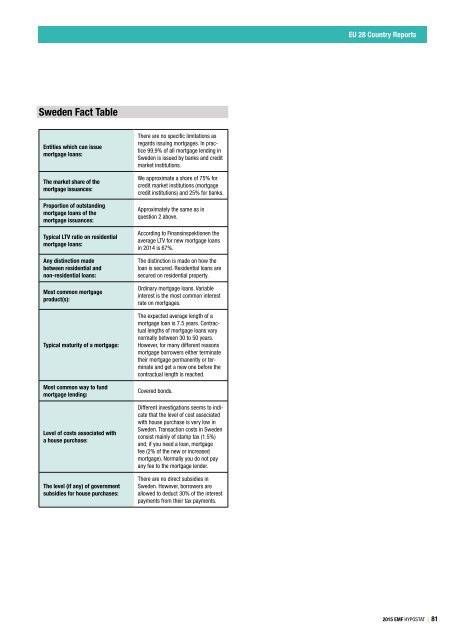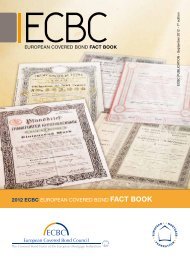Hypostat 2015
On 30 September 2015, the EMF-ECBC published Hypostat 2015 , which is its main statistical report, encompassing data on recent developments in housing and mortgage markets in the EU28 and beyond. Hypostat is the result of a collaborative effort by the European Mortgage Federation’s national delegations and external experts. The publication covers 33 countries – i.e. the EU28 plus Iceland, Norway, Russia, Turkey and the United States.
On 30 September 2015, the EMF-ECBC published Hypostat 2015 , which is its main statistical report, encompassing data on recent developments in housing and mortgage markets in the EU28 and beyond. Hypostat is the result of a collaborative effort by the European Mortgage Federation’s national delegations and external experts.
The publication covers 33 countries – i.e. the EU28 plus Iceland, Norway, Russia, Turkey and the United States.
You also want an ePaper? Increase the reach of your titles
YUMPU automatically turns print PDFs into web optimized ePapers that Google loves.
EU 28 Country Reports<br />
Sweden Fact Table<br />
Entities which can issue<br />
mortgage loans:<br />
The market share of the<br />
mortgage issuances:<br />
Proportion of outstanding<br />
mortgage loans of the<br />
mortgage issuances:<br />
Typical LTV ratio on residential<br />
mortgage loans:<br />
Any distinction made<br />
between residential and<br />
non‐residential loans:<br />
Most common mortgage<br />
product(s):<br />
Typical maturity of a mortgage:<br />
Most common way to fund<br />
mortgage lending:<br />
Level of costs associated with<br />
a house purchase:<br />
The level (if any) of government<br />
subsidies for house purchases:<br />
There are no specific limitations as<br />
regards issuing mortgages. In practice<br />
99,9% of all mortgage lending in<br />
Sweden is issued by banks and credit<br />
market institutions.<br />
We approximate a share of 75% for<br />
credit market institutions (mortgage<br />
credit institutions) and 25% for banks.<br />
Approximately the same as in<br />
question 2 above.<br />
According to Finansinspektionen the<br />
average LTV for new mortgage loans<br />
in 2014 is 67%.<br />
The distinction is made on how the<br />
loan is secured. Residential loans are<br />
secured on residential property.<br />
Ordinary mortgage loans. Variable<br />
interest is the most common interest<br />
rate on mortgages.<br />
The expected average length of a<br />
mortgage loan is 7.5 years. Contractual<br />
lengths of mortgage loans vary<br />
normally between 30 to 50 years.<br />
However, for many different reasons<br />
mortgage borrowers either terminate<br />
their mortgage permanently or terminate<br />
and get a new one before the<br />
contractual length is reached.<br />
Covered bonds.<br />
Different investigations seems to indicate<br />
that the level of cost associated<br />
with house purchase is very low in<br />
Sweden. Transaction costs in Sweden<br />
consist mainly of stamp tax (1.5%)<br />
and, if you need a loan, mortgage<br />
fee (2% of the new or increased<br />
mortgage). Normally you do not pay<br />
any fee to the mortgage lender.<br />
There are no direct subsidies in<br />
Sweden. However, borrowers are<br />
allowed to deduct 30% of the interest<br />
payments from their tax payments.<br />
<strong>2015</strong> EMF HYPOSTAT | 81



